Accounting Report: GST, Tax Documentation, and Compliance Analysis
VerifiedAdded on 2020/06/06
|8
|1996
|51
Report
AI Summary
This report provides a comprehensive overview of Goods and Services Tax (GST) and tax documentation in the Australian context. It begins by outlining the GST registration process with the Australian Taxation Office (ATO), emphasizing the benefits of registration and the steps involved. The report then delves into taxable and GST-free supplies, clarifying the criteria for each and providing examples. It explains input tax credits, the Business Activity Statement (BAS), and lodgement dates, highlighting the importance of timely tax return filing. Furthermore, it discusses various types of penalties imposed by the ATO for non-compliance. Activity 3 focuses on business documents, detailing the types of records required and the time limits for retention. The report also includes research on GST-free supplies, input-taxed supplies, and the information required for a valid tax invoice. The conclusion summarizes the key findings, emphasizing the effective implementation of GST in Australia and the consequences of non-compliance. The report references relevant books, journals, and online resources to support its analysis.
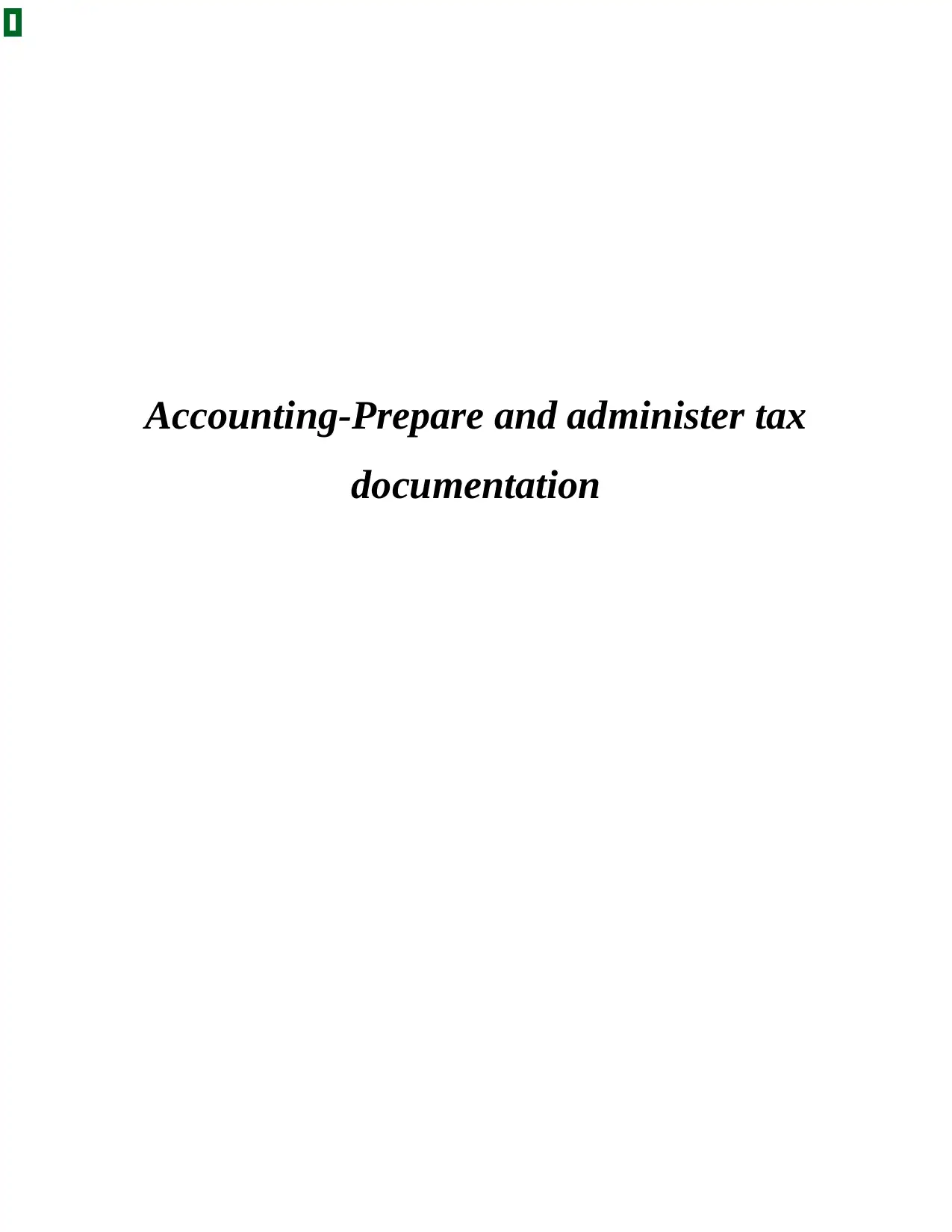
Accounting-Prepare and administer tax
documentation
documentation
Paraphrase This Document
Need a fresh take? Get an instant paraphrase of this document with our AI Paraphraser
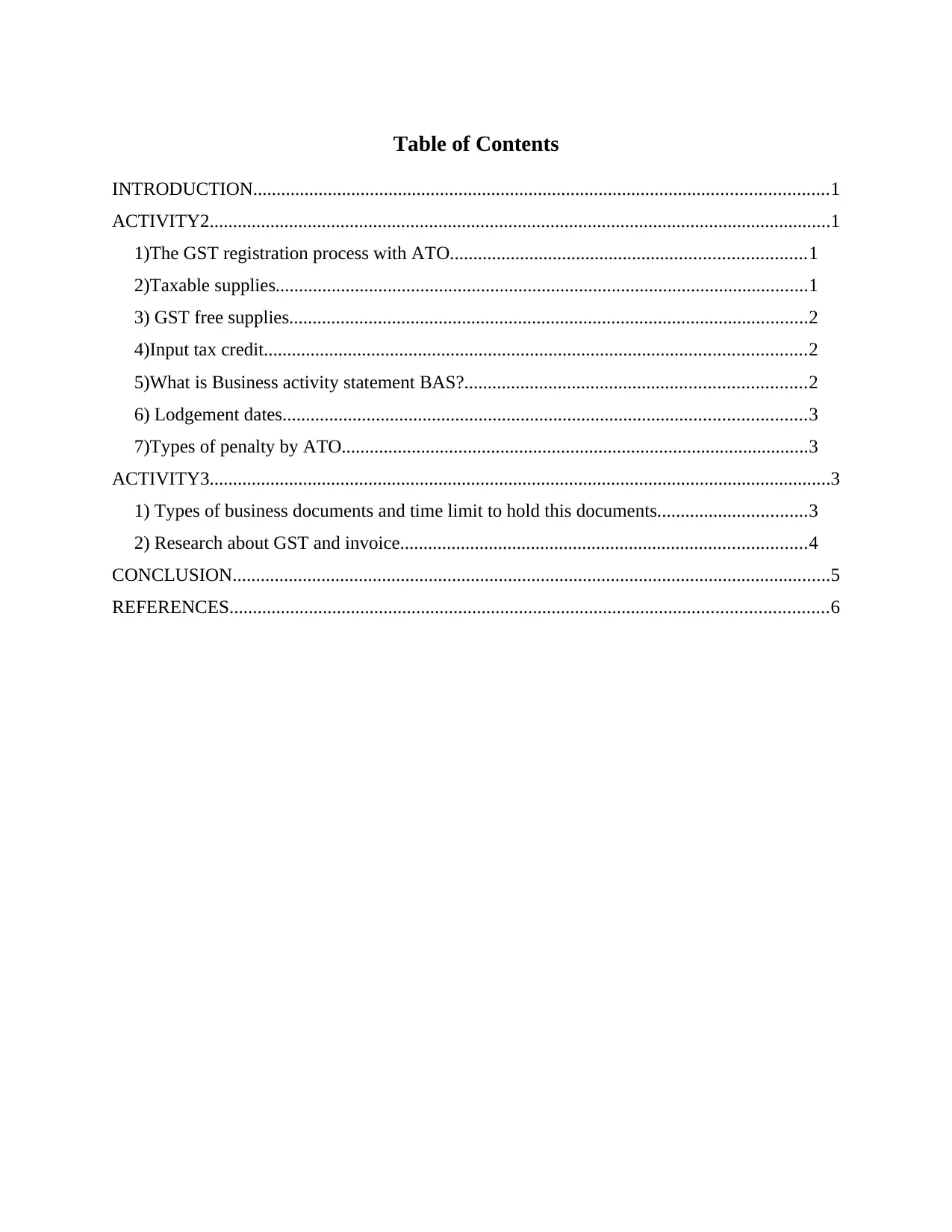
Table of Contents
INTRODUCTION...........................................................................................................................1
ACTIVITY2.....................................................................................................................................1
1)The GST registration process with ATO............................................................................1
2)Taxable supplies..................................................................................................................1
3) GST free supplies...............................................................................................................2
4)Input tax credit....................................................................................................................2
5)What is Business activity statement BAS?.........................................................................2
6) Lodgement dates................................................................................................................3
7)Types of penalty by ATO....................................................................................................3
ACTIVITY3.....................................................................................................................................3
1) Types of business documents and time limit to hold this documents................................3
2) Research about GST and invoice.......................................................................................4
CONCLUSION................................................................................................................................5
REFERENCES................................................................................................................................6
INTRODUCTION...........................................................................................................................1
ACTIVITY2.....................................................................................................................................1
1)The GST registration process with ATO............................................................................1
2)Taxable supplies..................................................................................................................1
3) GST free supplies...............................................................................................................2
4)Input tax credit....................................................................................................................2
5)What is Business activity statement BAS?.........................................................................2
6) Lodgement dates................................................................................................................3
7)Types of penalty by ATO....................................................................................................3
ACTIVITY3.....................................................................................................................................3
1) Types of business documents and time limit to hold this documents................................3
2) Research about GST and invoice.......................................................................................4
CONCLUSION................................................................................................................................5
REFERENCES................................................................................................................................6
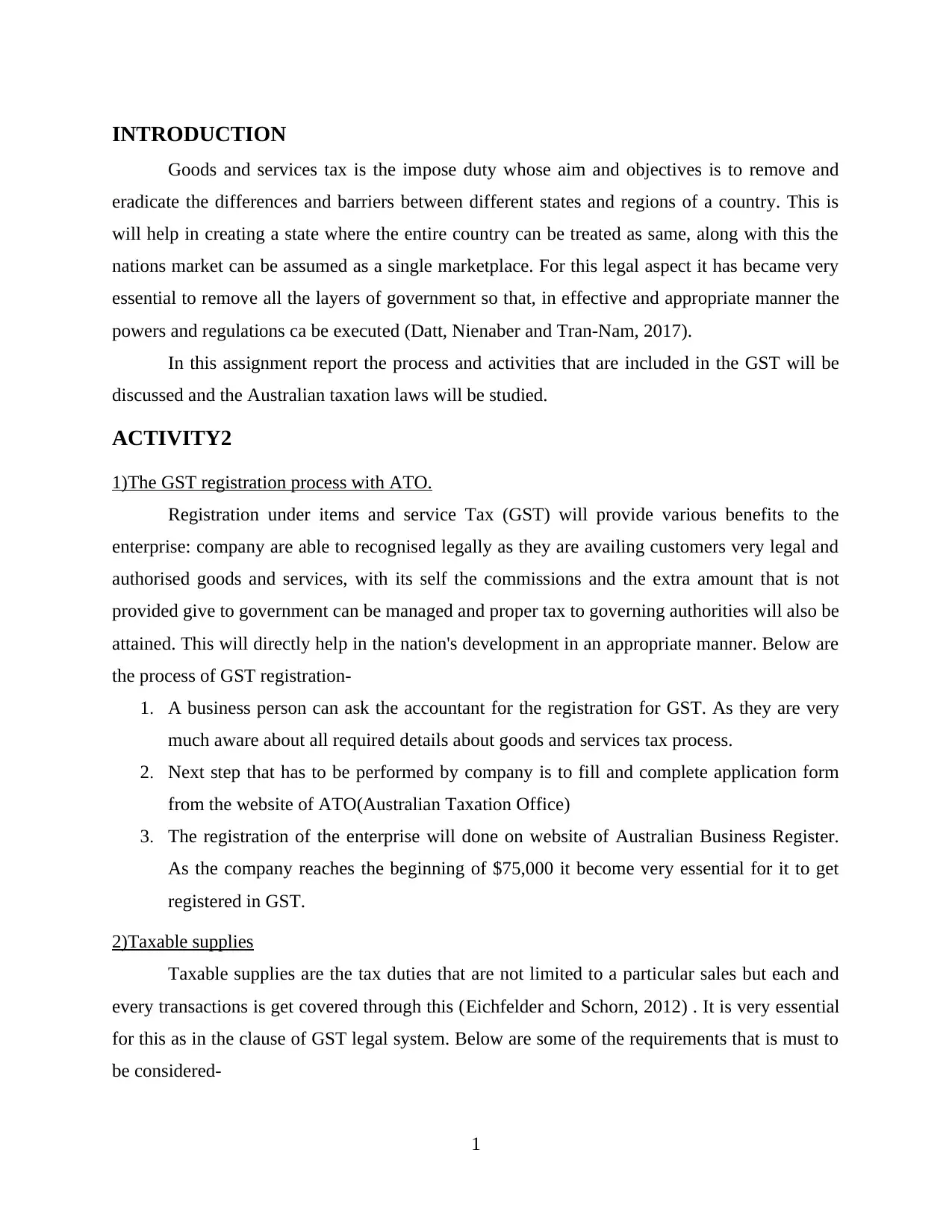
INTRODUCTION
Goods and services tax is the impose duty whose aim and objectives is to remove and
eradicate the differences and barriers between different states and regions of a country. This is
will help in creating a state where the entire country can be treated as same, along with this the
nations market can be assumed as a single marketplace. For this legal aspect it has became very
essential to remove all the layers of government so that, in effective and appropriate manner the
powers and regulations ca be executed (Datt, Nienaber and Tran-Nam, 2017).
In this assignment report the process and activities that are included in the GST will be
discussed and the Australian taxation laws will be studied.
ACTIVITY2
1)The GST registration process with ATO.
Registration under items and service Tax (GST) will provide various benefits to the
enterprise: company are able to recognised legally as they are availing customers very legal and
authorised goods and services, with its self the commissions and the extra amount that is not
provided give to government can be managed and proper tax to governing authorities will also be
attained. This will directly help in the nation's development in an appropriate manner. Below are
the process of GST registration-
1. A business person can ask the accountant for the registration for GST. As they are very
much aware about all required details about goods and services tax process.
2. Next step that has to be performed by company is to fill and complete application form
from the website of ATO(Australian Taxation Office)
3. The registration of the enterprise will done on website of Australian Business Register.
As the company reaches the beginning of $75,000 it become very essential for it to get
registered in GST.
2)Taxable supplies
Taxable supplies are the tax duties that are not limited to a particular sales but each and
every transactions is get covered through this (Eichfelder and Schorn, 2012) . It is very essential
for this as in the clause of GST legal system. Below are some of the requirements that is must to
be considered-
1
Goods and services tax is the impose duty whose aim and objectives is to remove and
eradicate the differences and barriers between different states and regions of a country. This is
will help in creating a state where the entire country can be treated as same, along with this the
nations market can be assumed as a single marketplace. For this legal aspect it has became very
essential to remove all the layers of government so that, in effective and appropriate manner the
powers and regulations ca be executed (Datt, Nienaber and Tran-Nam, 2017).
In this assignment report the process and activities that are included in the GST will be
discussed and the Australian taxation laws will be studied.
ACTIVITY2
1)The GST registration process with ATO.
Registration under items and service Tax (GST) will provide various benefits to the
enterprise: company are able to recognised legally as they are availing customers very legal and
authorised goods and services, with its self the commissions and the extra amount that is not
provided give to government can be managed and proper tax to governing authorities will also be
attained. This will directly help in the nation's development in an appropriate manner. Below are
the process of GST registration-
1. A business person can ask the accountant for the registration for GST. As they are very
much aware about all required details about goods and services tax process.
2. Next step that has to be performed by company is to fill and complete application form
from the website of ATO(Australian Taxation Office)
3. The registration of the enterprise will done on website of Australian Business Register.
As the company reaches the beginning of $75,000 it become very essential for it to get
registered in GST.
2)Taxable supplies
Taxable supplies are the tax duties that are not limited to a particular sales but each and
every transactions is get covered through this (Eichfelder and Schorn, 2012) . It is very essential
for this as in the clause of GST legal system. Below are some of the requirements that is must to
be considered-
1
⊘ This is a preview!⊘
Do you want full access?
Subscribe today to unlock all pages.

Trusted by 1+ million students worldwide
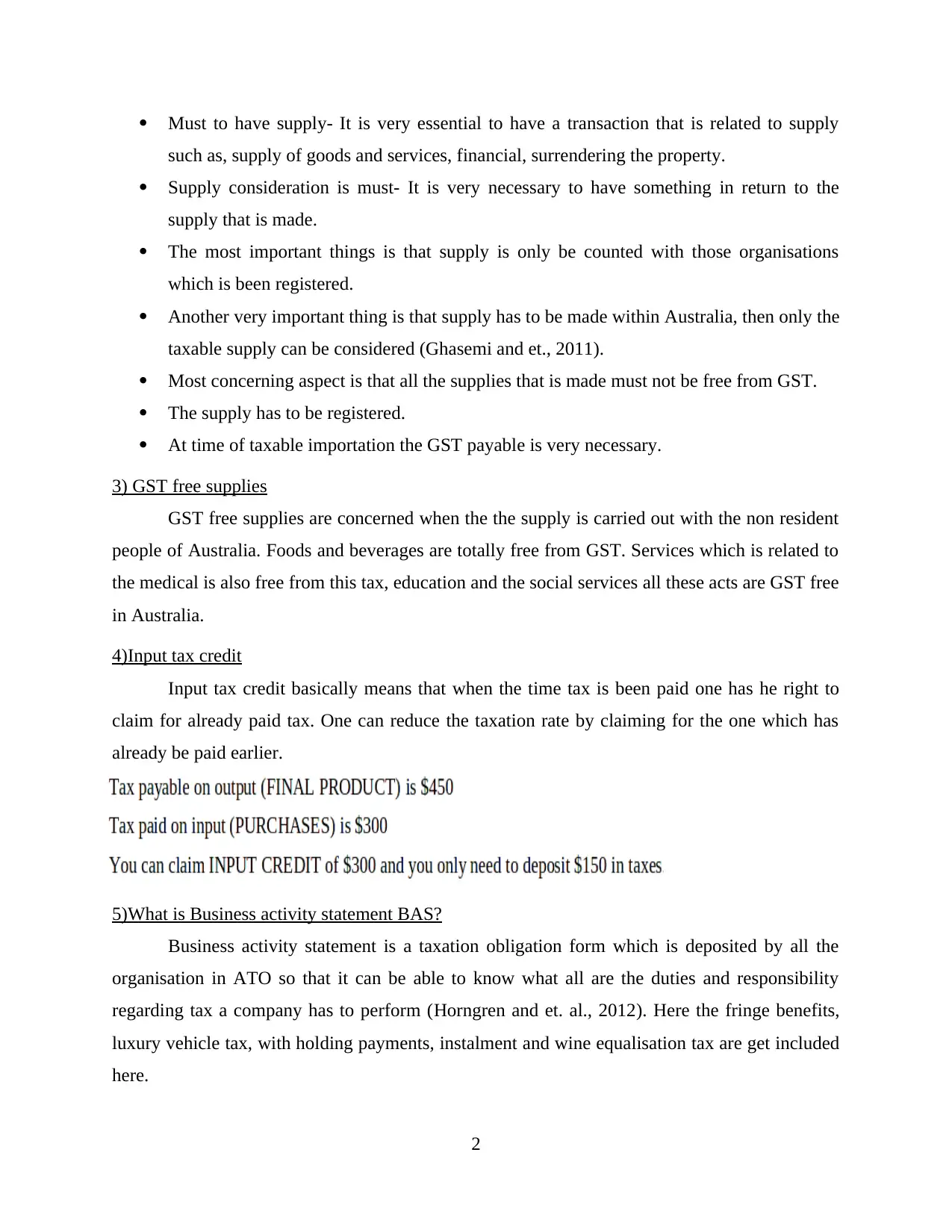
Must to have supply- It is very essential to have a transaction that is related to supply
such as, supply of goods and services, financial, surrendering the property.
Supply consideration is must- It is very necessary to have something in return to the
supply that is made.
The most important things is that supply is only be counted with those organisations
which is been registered.
Another very important thing is that supply has to be made within Australia, then only the
taxable supply can be considered (Ghasemi and et., 2011).
Most concerning aspect is that all the supplies that is made must not be free from GST.
The supply has to be registered.
At time of taxable importation the GST payable is very necessary.
3) GST free supplies
GST free supplies are concerned when the the supply is carried out with the non resident
people of Australia. Foods and beverages are totally free from GST. Services which is related to
the medical is also free from this tax, education and the social services all these acts are GST free
in Australia.
4)Input tax credit
Input tax credit basically means that when the time tax is been paid one has he right to
claim for already paid tax. One can reduce the taxation rate by claiming for the one which has
already be paid earlier.
5)What is Business activity statement BAS?
Business activity statement is a taxation obligation form which is deposited by all the
organisation in ATO so that it can be able to know what all are the duties and responsibility
regarding tax a company has to perform (Horngren and et. al., 2012). Here the fringe benefits,
luxury vehicle tax, with holding payments, instalment and wine equalisation tax are get included
here.
2
such as, supply of goods and services, financial, surrendering the property.
Supply consideration is must- It is very necessary to have something in return to the
supply that is made.
The most important things is that supply is only be counted with those organisations
which is been registered.
Another very important thing is that supply has to be made within Australia, then only the
taxable supply can be considered (Ghasemi and et., 2011).
Most concerning aspect is that all the supplies that is made must not be free from GST.
The supply has to be registered.
At time of taxable importation the GST payable is very necessary.
3) GST free supplies
GST free supplies are concerned when the the supply is carried out with the non resident
people of Australia. Foods and beverages are totally free from GST. Services which is related to
the medical is also free from this tax, education and the social services all these acts are GST free
in Australia.
4)Input tax credit
Input tax credit basically means that when the time tax is been paid one has he right to
claim for already paid tax. One can reduce the taxation rate by claiming for the one which has
already be paid earlier.
5)What is Business activity statement BAS?
Business activity statement is a taxation obligation form which is deposited by all the
organisation in ATO so that it can be able to know what all are the duties and responsibility
regarding tax a company has to perform (Horngren and et. al., 2012). Here the fringe benefits,
luxury vehicle tax, with holding payments, instalment and wine equalisation tax are get included
here.
2
Paraphrase This Document
Need a fresh take? Get an instant paraphrase of this document with our AI Paraphraser
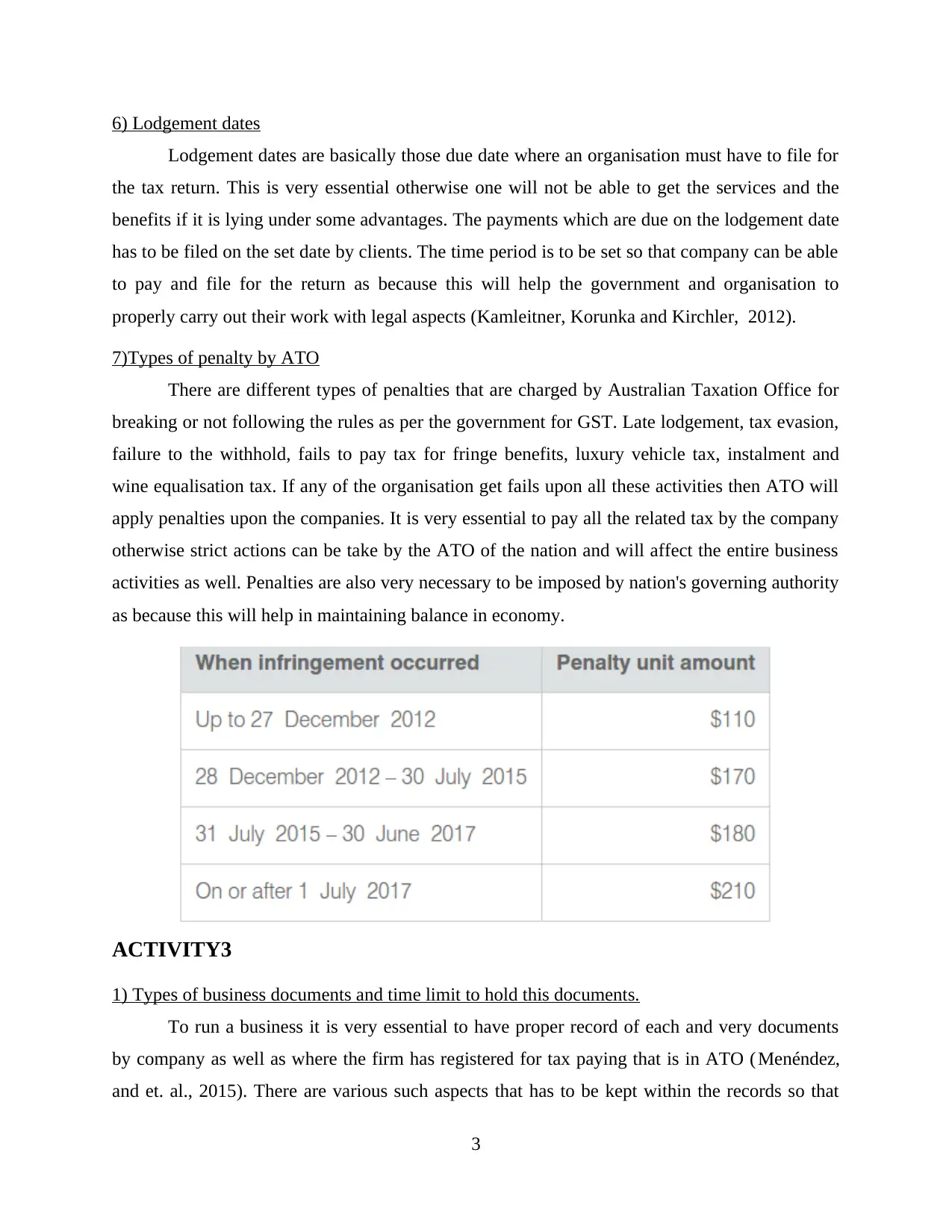
6) Lodgement dates
Lodgement dates are basically those due date where an organisation must have to file for
the tax return. This is very essential otherwise one will not be able to get the services and the
benefits if it is lying under some advantages. The payments which are due on the lodgement date
has to be filed on the set date by clients. The time period is to be set so that company can be able
to pay and file for the return as because this will help the government and organisation to
properly carry out their work with legal aspects (Kamleitner, Korunka and Kirchler, 2012).
7)Types of penalty by ATO
There are different types of penalties that are charged by Australian Taxation Office for
breaking or not following the rules as per the government for GST. Late lodgement, tax evasion,
failure to the withhold, fails to pay tax for fringe benefits, luxury vehicle tax, instalment and
wine equalisation tax. If any of the organisation get fails upon all these activities then ATO will
apply penalties upon the companies. It is very essential to pay all the related tax by the company
otherwise strict actions can be take by the ATO of the nation and will affect the entire business
activities as well. Penalties are also very necessary to be imposed by nation's governing authority
as because this will help in maintaining balance in economy.
ACTIVITY3
1) Types of business documents and time limit to hold this documents.
To run a business it is very essential to have proper record of each and very documents
by company as well as where the firm has registered for tax paying that is in ATO (Menéndez,
and et. al., 2015). There are various such aspects that has to be kept within the records so that
3
Lodgement dates are basically those due date where an organisation must have to file for
the tax return. This is very essential otherwise one will not be able to get the services and the
benefits if it is lying under some advantages. The payments which are due on the lodgement date
has to be filed on the set date by clients. The time period is to be set so that company can be able
to pay and file for the return as because this will help the government and organisation to
properly carry out their work with legal aspects (Kamleitner, Korunka and Kirchler, 2012).
7)Types of penalty by ATO
There are different types of penalties that are charged by Australian Taxation Office for
breaking or not following the rules as per the government for GST. Late lodgement, tax evasion,
failure to the withhold, fails to pay tax for fringe benefits, luxury vehicle tax, instalment and
wine equalisation tax. If any of the organisation get fails upon all these activities then ATO will
apply penalties upon the companies. It is very essential to pay all the related tax by the company
otherwise strict actions can be take by the ATO of the nation and will affect the entire business
activities as well. Penalties are also very necessary to be imposed by nation's governing authority
as because this will help in maintaining balance in economy.
ACTIVITY3
1) Types of business documents and time limit to hold this documents.
To run a business it is very essential to have proper record of each and very documents
by company as well as where the firm has registered for tax paying that is in ATO (Menéndez,
and et. al., 2015). There are various such aspects that has to be kept within the records so that
3
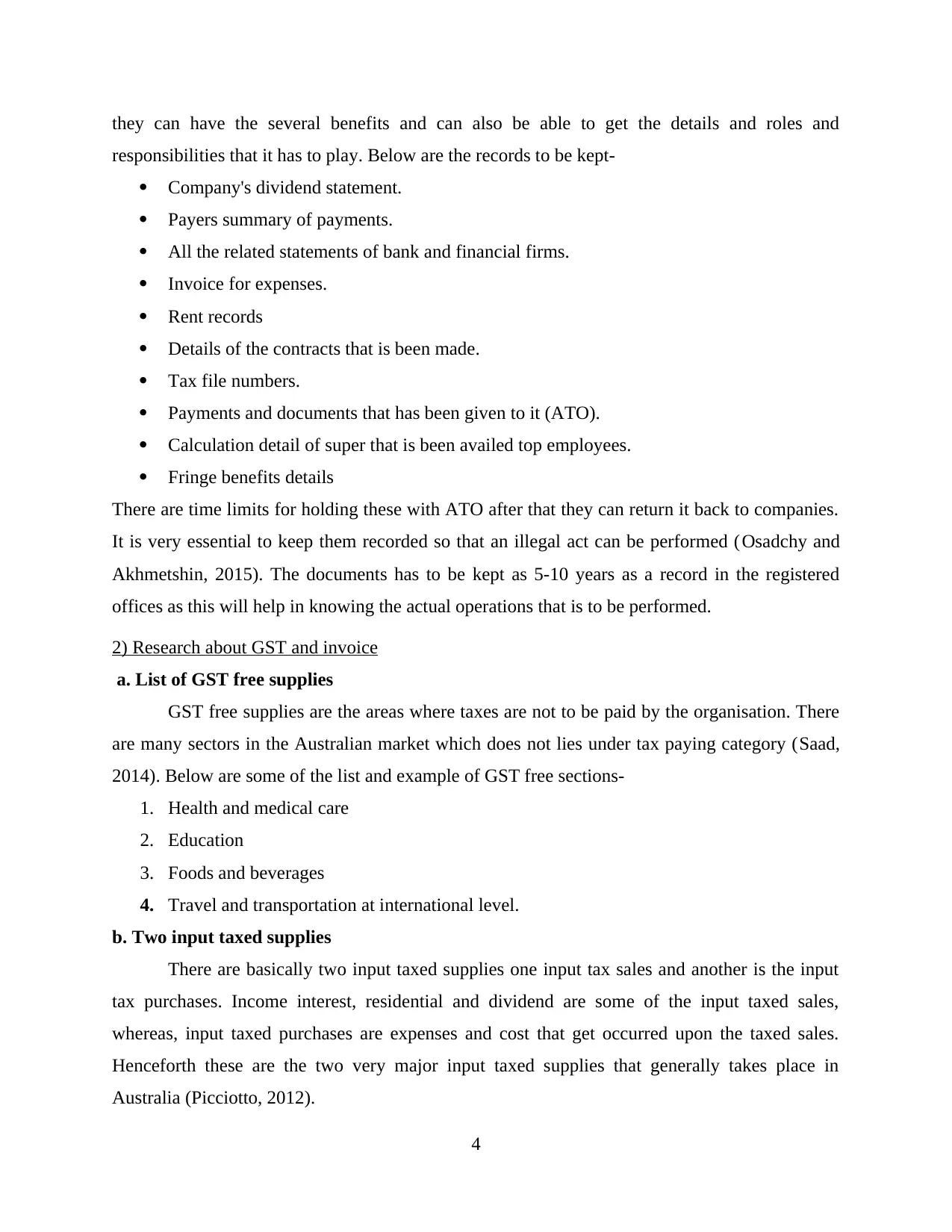
they can have the several benefits and can also be able to get the details and roles and
responsibilities that it has to play. Below are the records to be kept-
Company's dividend statement.
Payers summary of payments.
All the related statements of bank and financial firms.
Invoice for expenses.
Rent records
Details of the contracts that is been made.
Tax file numbers.
Payments and documents that has been given to it (ATO).
Calculation detail of super that is been availed top employees.
Fringe benefits details
There are time limits for holding these with ATO after that they can return it back to companies.
It is very essential to keep them recorded so that an illegal act can be performed (Osadchy and
Akhmetshin, 2015). The documents has to be kept as 5-10 years as a record in the registered
offices as this will help in knowing the actual operations that is to be performed.
2) Research about GST and invoice
a. List of GST free supplies
GST free supplies are the areas where taxes are not to be paid by the organisation. There
are many sectors in the Australian market which does not lies under tax paying category (Saad,
2014). Below are some of the list and example of GST free sections-
1. Health and medical care
2. Education
3. Foods and beverages
4. Travel and transportation at international level.
b. Two input taxed supplies
There are basically two input taxed supplies one input tax sales and another is the input
tax purchases. Income interest, residential and dividend are some of the input taxed sales,
whereas, input taxed purchases are expenses and cost that get occurred upon the taxed sales.
Henceforth these are the two very major input taxed supplies that generally takes place in
Australia (Picciotto, 2012).
4
responsibilities that it has to play. Below are the records to be kept-
Company's dividend statement.
Payers summary of payments.
All the related statements of bank and financial firms.
Invoice for expenses.
Rent records
Details of the contracts that is been made.
Tax file numbers.
Payments and documents that has been given to it (ATO).
Calculation detail of super that is been availed top employees.
Fringe benefits details
There are time limits for holding these with ATO after that they can return it back to companies.
It is very essential to keep them recorded so that an illegal act can be performed (Osadchy and
Akhmetshin, 2015). The documents has to be kept as 5-10 years as a record in the registered
offices as this will help in knowing the actual operations that is to be performed.
2) Research about GST and invoice
a. List of GST free supplies
GST free supplies are the areas where taxes are not to be paid by the organisation. There
are many sectors in the Australian market which does not lies under tax paying category (Saad,
2014). Below are some of the list and example of GST free sections-
1. Health and medical care
2. Education
3. Foods and beverages
4. Travel and transportation at international level.
b. Two input taxed supplies
There are basically two input taxed supplies one input tax sales and another is the input
tax purchases. Income interest, residential and dividend are some of the input taxed sales,
whereas, input taxed purchases are expenses and cost that get occurred upon the taxed sales.
Henceforth these are the two very major input taxed supplies that generally takes place in
Australia (Picciotto, 2012).
4
⊘ This is a preview!⊘
Do you want full access?
Subscribe today to unlock all pages.

Trusted by 1+ million students worldwide
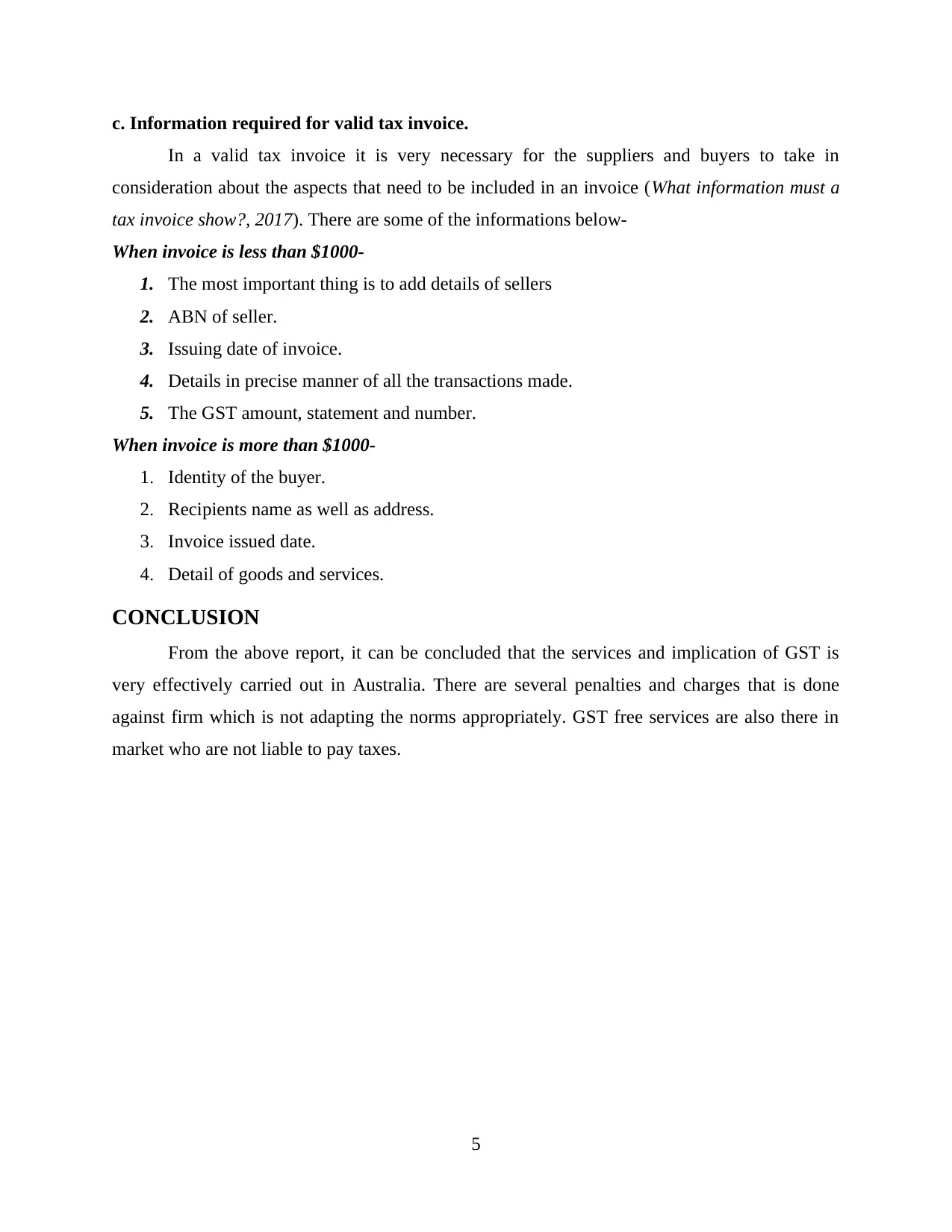
c. Information required for valid tax invoice.
In a valid tax invoice it is very necessary for the suppliers and buyers to take in
consideration about the aspects that need to be included in an invoice (What information must a
tax invoice show?, 2017). There are some of the informations below-
When invoice is less than $1000-
1. The most important thing is to add details of sellers
2. ABN of seller.
3. Issuing date of invoice.
4. Details in precise manner of all the transactions made.
5. The GST amount, statement and number.
When invoice is more than $1000-
1. Identity of the buyer.
2. Recipients name as well as address.
3. Invoice issued date.
4. Detail of goods and services.
CONCLUSION
From the above report, it can be concluded that the services and implication of GST is
very effectively carried out in Australia. There are several penalties and charges that is done
against firm which is not adapting the norms appropriately. GST free services are also there in
market who are not liable to pay taxes.
5
In a valid tax invoice it is very necessary for the suppliers and buyers to take in
consideration about the aspects that need to be included in an invoice (What information must a
tax invoice show?, 2017). There are some of the informations below-
When invoice is less than $1000-
1. The most important thing is to add details of sellers
2. ABN of seller.
3. Issuing date of invoice.
4. Details in precise manner of all the transactions made.
5. The GST amount, statement and number.
When invoice is more than $1000-
1. Identity of the buyer.
2. Recipients name as well as address.
3. Invoice issued date.
4. Detail of goods and services.
CONCLUSION
From the above report, it can be concluded that the services and implication of GST is
very effectively carried out in Australia. There are several penalties and charges that is done
against firm which is not adapting the norms appropriately. GST free services are also there in
market who are not liable to pay taxes.
5
Paraphrase This Document
Need a fresh take? Get an instant paraphrase of this document with our AI Paraphraser
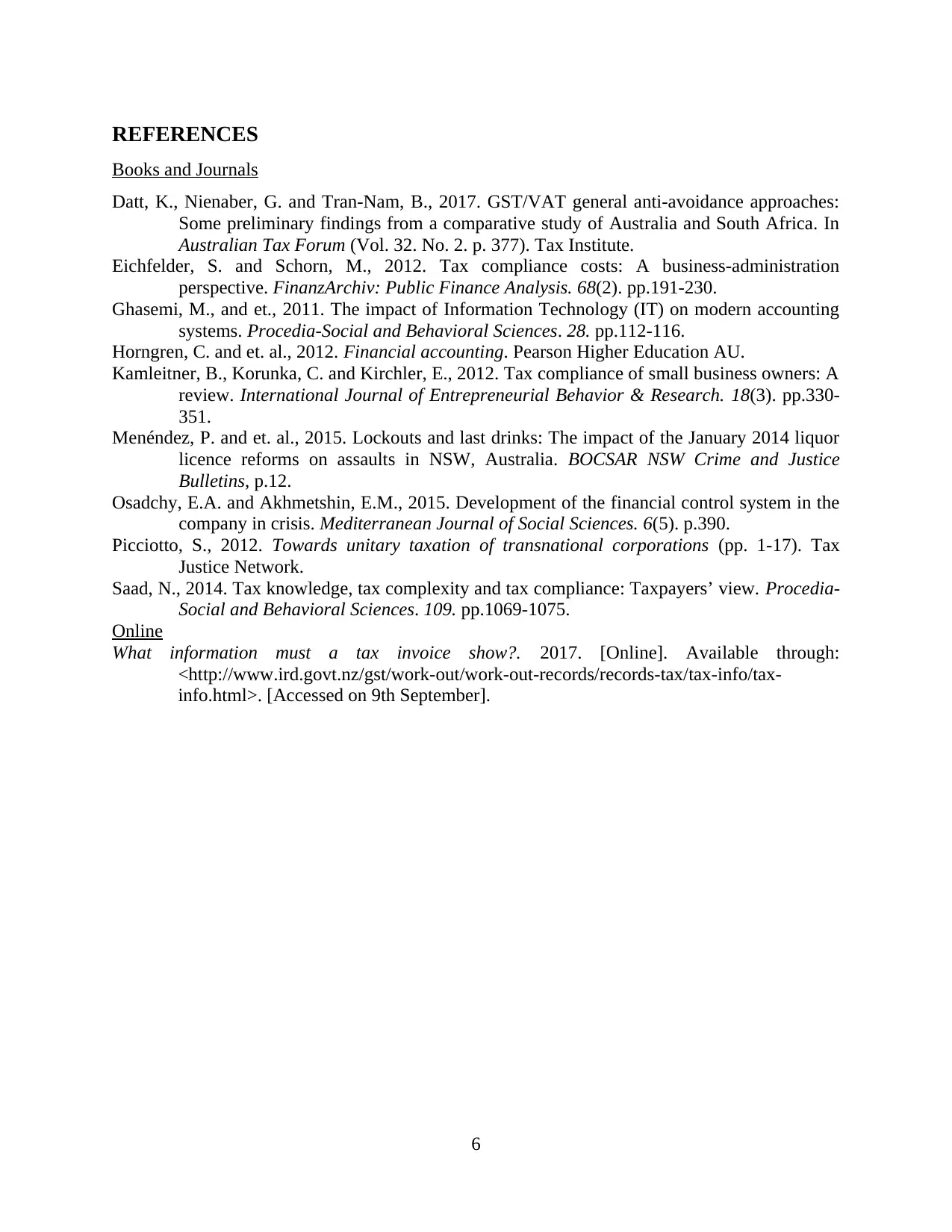
REFERENCES
Books and Journals
Datt, K., Nienaber, G. and Tran-Nam, B., 2017. GST/VAT general anti-avoidance approaches:
Some preliminary findings from a comparative study of Australia and South Africa. In
Australian Tax Forum (Vol. 32. No. 2. p. 377). Tax Institute.
Eichfelder, S. and Schorn, M., 2012. Tax compliance costs: A business-administration
perspective. FinanzArchiv: Public Finance Analysis. 68(2). pp.191-230.
Ghasemi, M., and et., 2011. The impact of Information Technology (IT) on modern accounting
systems. Procedia-Social and Behavioral Sciences. 28. pp.112-116.
Horngren, C. and et. al., 2012. Financial accounting. Pearson Higher Education AU.
Kamleitner, B., Korunka, C. and Kirchler, E., 2012. Tax compliance of small business owners: A
review. International Journal of Entrepreneurial Behavior & Research. 18(3). pp.330-
351.
Menéndez, P. and et. al., 2015. Lockouts and last drinks: The impact of the January 2014 liquor
licence reforms on assaults in NSW, Australia. BOCSAR NSW Crime and Justice
Bulletins, p.12.
Osadchy, E.A. and Akhmetshin, E.M., 2015. Development of the financial control system in the
company in crisis. Mediterranean Journal of Social Sciences. 6(5). p.390.
Picciotto, S., 2012. Towards unitary taxation of transnational corporations (pp. 1-17). Tax
Justice Network.
Saad, N., 2014. Tax knowledge, tax complexity and tax compliance: Taxpayers’ view. Procedia-
Social and Behavioral Sciences. 109. pp.1069-1075.
Online
What information must a tax invoice show?. 2017. [Online]. Available through:
<http://www.ird.govt.nz/gst/work-out/work-out-records/records-tax/tax-info/tax-
info.html>. [Accessed on 9th September].
6
Books and Journals
Datt, K., Nienaber, G. and Tran-Nam, B., 2017. GST/VAT general anti-avoidance approaches:
Some preliminary findings from a comparative study of Australia and South Africa. In
Australian Tax Forum (Vol. 32. No. 2. p. 377). Tax Institute.
Eichfelder, S. and Schorn, M., 2012. Tax compliance costs: A business-administration
perspective. FinanzArchiv: Public Finance Analysis. 68(2). pp.191-230.
Ghasemi, M., and et., 2011. The impact of Information Technology (IT) on modern accounting
systems. Procedia-Social and Behavioral Sciences. 28. pp.112-116.
Horngren, C. and et. al., 2012. Financial accounting. Pearson Higher Education AU.
Kamleitner, B., Korunka, C. and Kirchler, E., 2012. Tax compliance of small business owners: A
review. International Journal of Entrepreneurial Behavior & Research. 18(3). pp.330-
351.
Menéndez, P. and et. al., 2015. Lockouts and last drinks: The impact of the January 2014 liquor
licence reforms on assaults in NSW, Australia. BOCSAR NSW Crime and Justice
Bulletins, p.12.
Osadchy, E.A. and Akhmetshin, E.M., 2015. Development of the financial control system in the
company in crisis. Mediterranean Journal of Social Sciences. 6(5). p.390.
Picciotto, S., 2012. Towards unitary taxation of transnational corporations (pp. 1-17). Tax
Justice Network.
Saad, N., 2014. Tax knowledge, tax complexity and tax compliance: Taxpayers’ view. Procedia-
Social and Behavioral Sciences. 109. pp.1069-1075.
Online
What information must a tax invoice show?. 2017. [Online]. Available through:
<http://www.ird.govt.nz/gst/work-out/work-out-records/records-tax/tax-info/tax-
info.html>. [Accessed on 9th September].
6
1 out of 8
Related Documents
Your All-in-One AI-Powered Toolkit for Academic Success.
+13062052269
info@desklib.com
Available 24*7 on WhatsApp / Email
![[object Object]](/_next/static/media/star-bottom.7253800d.svg)
Unlock your academic potential
Copyright © 2020–2025 A2Z Services. All Rights Reserved. Developed and managed by ZUCOL.



